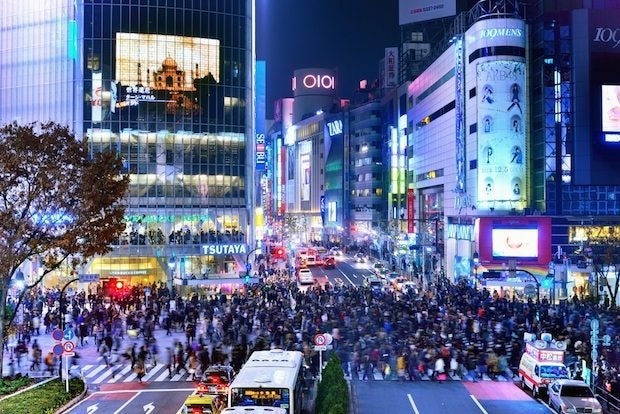
Japan saw a Chinese tourist rebound in 2014 as shoppers flooded into Tokyo, pictured above, to take advantage of a weak yen. (Shutterstock)
Tumultuous politics across Asia and Chinese tourists’ love for duty-free shopping meant that South Korea and Japan came out as the big winners in China’s booming tourism industry for 2014.
While Europe and North America have been vying for a greater piece of China’s international travel market, Asia remained the clear global leader for attracting Chinese visitors over the past year. As more than 100 million Chinese travelers took international trips in 2014, Asia saw the lion’s share of visitors with 89.5 percent of outbound Chinese departures as of the beginning of December. The region saw 85.4 million Chinese travelers as of November, surging far ahead of Europe, which came in second with 3.4 million over the same period, and third-place Africa which saw 2.7 million Chinese visitors.
While China’s Special Administrative Regions Hong Kong and Macau remained Asia’s top destinations outside mainland China for Chinese visitors, South Korea is now the region's third most popular destination for Chinese tourists with an estimated 6.1 million total visitors from China in 2014. With a 40.9 percent year-on-year growth rate, the country has benefited from China's obsession with Hallyu (a Korean word that means "Korean Wave," referring to the strong influence of Korean pop culture), as well as visa-free travel for Chinese visitors to Jejudo Island.
Meanwhile, fifth-place Japan saw 80 percent year-on-year growth rate for 2.22 million Chinese tourists in the first 11 months of 2014. The growth marks a significant rebound that began in January of this year after over a year-long slump. Chinese visitor numbers took a dive starting in 2012 as a result of Chinese anti-Japan riots and boycotts over the Senkaku Islands dispute between China and Japan.
Chinese shoppers’ high demand for tariff-free luxury goods played a major part in Chinese visitor growth for Japan and South Korea, which are both popular spots for duty-free shopping. “Chinese who love shopping have begun to feel the merits of shopping in Japan,” a Japan National Tourism Organization official told The Asahi Shimbun. Japan was an especially attractive retail destination as a weak yen meant that prices were especially cheap. In October, Japan added cosmetics to its list of duty-free products, further enticing Chinese shoppers hoping to stock up on Shiseido face cream. Political upheaval in duty-free destination Hong Kong may have also driven price-conscious Chinese luxury shoppers to Japan and South Korea as sales of jewelry, watches, and valuable gifts have fallen in recent months.
Japan and South Korea also benefited from Chinese visitors aiming to avoid many Southeast Asian countries at the center of political strife over the course of the year. Although Thailand came in ahead of Japan in fourth place for Chinese tourist arrivals this year, the country’s volatile political situation caused Chinese visitor numbers to slump despite 68 percent growth in the previous year. After Thailand's coup d'état in May, the number of Chinese visitors dropped 41 percent in June. This prompted Thailand’s new ruling junta to issue a visa fee waiver for Chinese visitors between August and November, leading to a slight rebound at the end of this year.
Thailand joins several Southeast Asian countries that had a rough year for Chinese visitor growth thanks to political issues. Malaysia took a major dent in its number of Chinese tourists after Chinese citizens became furious over what they saw as mismanagement of the search for Malaysia Airlines flight MH370 that was lost in March. In order to combat a 19 percent decline in the number of Chinese tourists over the first three quarters of 2014, Malaysia has loosened visa restrictions and upped promotional efforts in China—especially in second-tier cities including Wuhan, Chengdu, Tianjin, and Changsha. The effects of Malaysia’s slump have spilled into neighboring countries thanks to a decline in multi-country tour groups, causing Chinese visitor numbers to Singapore to decrease by 29 percent for the first three quarters of the year.
Although Malaysian officials were upbeat about the return of Chinese tourists, the recent crash of the Malaysian AirAsia flight 8501 is likely to cause even more of a detriment in the year to come. The tragedy is also already hitting Indonesia, where the flight was bound, as Chinese travelers cancel their Chinese New Year flights to Bali.
Meanwhile, Vietnam’s massive anti-China riots in May that prompted the evacuation of Chinese nationals from the country caused a 24 percent decrease in Chinese arrivals for the third quarter of the year despite the country’s earlier success in wooing visitors from China.
These dramatic ups and downs in Asia’s tourism market from year to year show that luxury retail and hotel brands should pay close attention to the top destinations for affluent Chinese visitors on both a long-term and short-term basis. For 2015, Thailand is plotting a full-scale comeback, while Taiwan is becoming a growing hotspot for Chinese shoppers. South Korea should remain strong, while Japan also hopes to remain popular. It's important to note that all of these optimistic forecasts are contingent on calm political situations, which can't always be guaranteed. While it's impossible to ignore stunning growth rates and high Chinese spending, its's also important that luxury brands look at long-term Chinese visitor growth and regional stability when plotting out promotions as well as regional expansion.